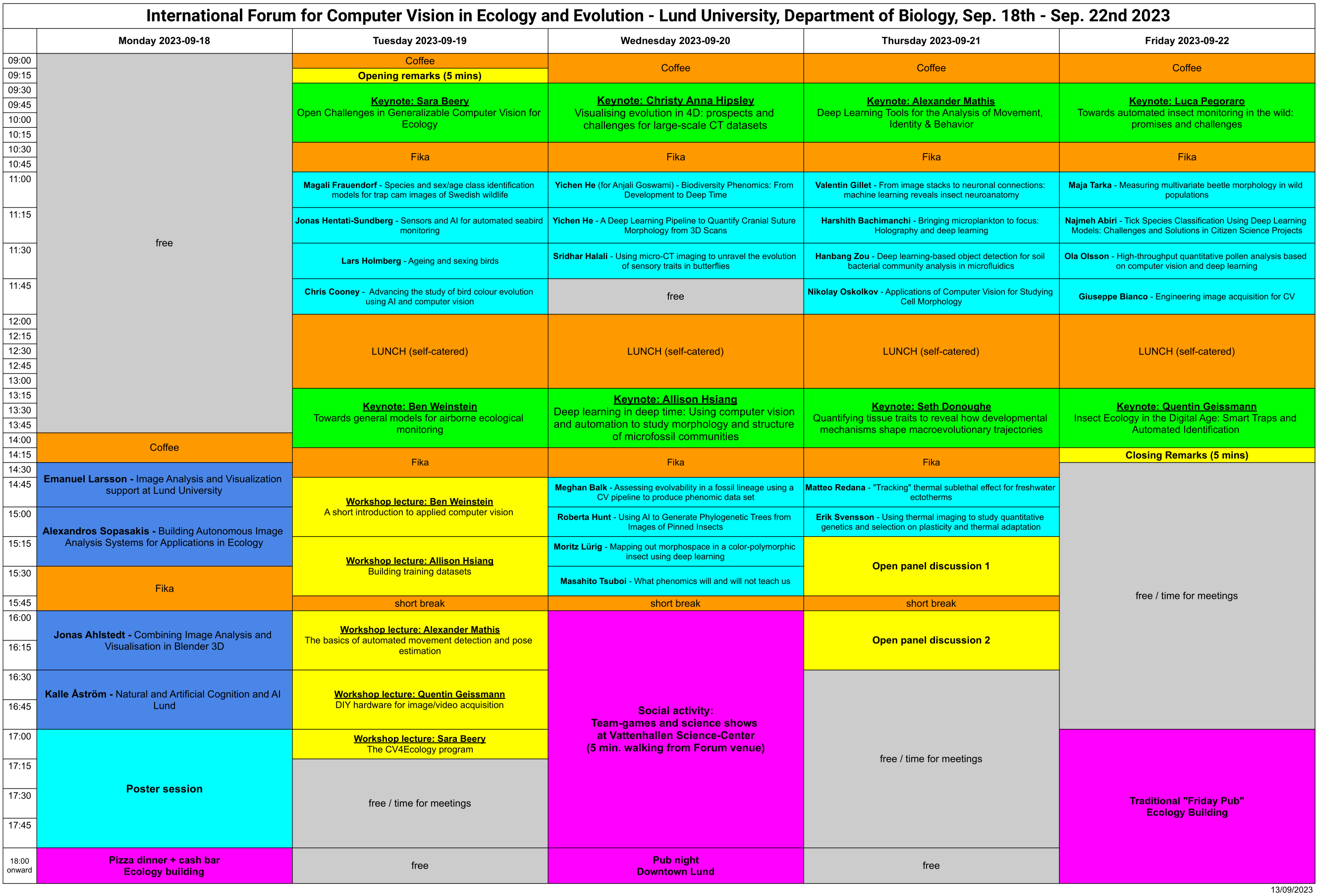Program & recorded talks
ProgramPermalink
- Special symposium (CV and AI at Lund University, Monday): Detailed program (with abstracts)
- Hans Kristiansson Symposium (Forum talks, Tuesday - Friday): Detailed program (with abstracts)
- Program overview (click to view as pdf):
Recorded talksPermalink
Keynote (45 mins)
Regular talk (15 mins)
Workshop lecture (30 mins)
- Monday (Day 1) - no recordings, sorry!
- Tuesday (Day 2)
- Wednesday (Day 3)
- Thursday (Day 4)
- Friday (Day 5)
Tuesday (Day 2)Permalink
Morning sessionPermalink
Sara Beery
Open Challenges in Generalizable Computer Vision for Ecology
Open Challenges in Generalizable Computer Vision for Ecology
Magali Frauendorf
Species and sex/age class identification models for trap cam images of Swedish wildlife
Species and sex/age class identification models for trap cam images of Swedish wildlife
Jonas Hentati-Sundberg
Sensors and AI for automated seabird monitoring
Sensors and AI for automated seabird monitoring
Lars Holmberg
Ageing and sexing birds
Ageing and sexing birds
Chris Cooney
Advancing the study of bird colour evolution using AI and computer vision
Advancing the study of bird colour evolution using AI and computer vision
Afternoon sessionPermalink
Ben Weinstein
Towards general models for airborne ecological monitoring
Towards general models for airborne ecological monitoring
Ben Weinstein
A short introduction to applied computer vision
A short introduction to applied computer vision
Alexander Mathis
The basics of automated movement detection and pose estimation
The basics of automated movement detection and pose estimation
Allison Hsiang
Building training datasets
Building training datasets
Quentin Geissmann
DIY hardware for image/video acquisition
DIY hardware for image/video acquisition
Sara Beery
The CV4Ecology program
The CV4Ecology program
Wednesday (Day 3)Permalink
Morning sessionPermalink

Christy Hipsley
Visualising evolution in 4D: prospects and challenges for large-scale CT datasets
Visualising evolution in 4D: prospects and challenges for large-scale CT datasets
Yichen He (for Anjali Goswami)
Biodiversity Phenomics: From Development to Deep Time
Biodiversity Phenomics: From Development to Deep Time
Yichen He
A Deep Learning Pipeline to Quantify Cranial Suture Morphology from 3D Scans
A Deep Learning Pipeline to Quantify Cranial Suture Morphology from 3D Scans
Sridhar Halali
Using micro-CT imaging to unravel the evolution of sensory traits in butterflies
Using micro-CT imaging to unravel the evolution of sensory traits in butterflies
Afternoon sessionPermalink
Allison Hsiang
Deep learning in deep time: Using computer vision and automation to study morphology and structure of microfossil communities
Deep learning in deep time: Using computer vision and automation to study morphology and structure of microfossil communities
Meghan Balk
Assessing evolvability in a fossil lineage using a CV pipeline to produce phenomic data set
Assessing evolvability in a fossil lineage using a CV pipeline to produce phenomic data set
Roberta Hunt
Using AI to Generate Phylogenetic Trees from Images of Pinned Insects
Using AI to Generate Phylogenetic Trees from Images of Pinned Insects
Moritz Lürig
Mapping out morphospace in a color-polymorphic insect using deep learning
Mapping out morphospace in a color-polymorphic insect using deep learning
Masahito Tsuboi
What phenomics will and will not teach us
What phenomics will and will not teach us
Thursday (Day 4)Permalink
Morning sessionPermalink
Alexander Mathis
Deep Learning Tools for the Analysis of Movement, Identity & Behavior
(same talk, but recorded on different occasion)
Deep Learning Tools for the Analysis of Movement, Identity & Behavior
(same talk, but recorded on different occasion)
Valentin Gillet
From image stacks to neuronal connections: machine learning reveals insect neuroanatomy
From image stacks to neuronal connections: machine learning reveals insect neuroanatomy
Harshith Bachimanchi
Bringing microplankton to focus: Holography and deep learning
Bringing microplankton to focus: Holography and deep learning
Hanbang Zou
Deep learning-based object detection for soil bacterial community analysis in microfluidics
Deep learning-based object detection for soil bacterial community analysis in microfluidics
Nikolay Oskolkov
Applications of Computer Vision for Studying Cell Morphology
Applications of Computer Vision for Studying Cell Morphology
Afternoon sessionPermalink
Seth Donoughe
Quantifying tissue traits to reveal how developmental mechanisms shape macroevolutionary trajectories
Quantifying tissue traits to reveal how developmental mechanisms shape macroevolutionary trajectories
Matteo Redana
Use of videotracking to understand sub-critical thermal effects of freshwater macroinvertebrates
Use of videotracking to understand sub-critical thermal effects of freshwater macroinvertebrates
Erik Svensson
Using thermal imaging to study quantitative genetics and selection on plasticity and thermal adaptation
Using thermal imaging to study quantitative genetics and selection on plasticity and thermal adaptation
Friday (Day 5)Permalink
Morning sessionPermalink
Luca Pegoraro
Keynote: Luca Pegoraro - Towards automated insect monitoring in the wild: promises and challenges
Keynote: Luca Pegoraro - Towards automated insect monitoring in the wild: promises and challenges
Maja Tarka
Measuring multivariate beetle morphology in wild populations
Measuring multivariate beetle morphology in wild populations
Najmeh Abiri
Tick Species Classification Using Deep Learning Models: Challenges and Solutions in Citizen Science Projects
Tick Species Classification Using Deep Learning Models: Challenges and Solutions in Citizen Science Projects
Ola Olsson
High-throughput quantitative pollen analysis based on computer vision and deep learning
High-throughput quantitative pollen analysis based on computer vision and deep learning
Giuseppe Bianco
Engineering image acquisition for CV
Engineering image acquisition for CV
Afternoon sessionPermalink
Quentin Geissmann
Insect Ecology in the Digital Age: Smart Traps and Automated Identification
Insect Ecology in the Digital Age: Smart Traps and Automated Identification
